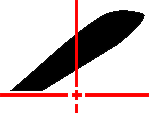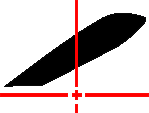-
I don't particularly care for
hard-surfaced runways. First, engines need a very low, reliable idle
or the model needs brakes to prevent the model from rolling off on it's own.
Second, asphalt isn't very forgiving of even minor mishaps such as touching
a wing tip.
Instead, all flying fields should
be made from perfectly manicured putting green grass. Even small
aircraft should roll on it fairly well. It's firm enough to prevent
wheels from digging in and causing nose-overs yet forgiving enough not to
cause damage to the finish if a wing tip drags over it lightly.
-
This one comes from Antonio
Amado and I like the idea so much that I've decided to wish for it myself.
Some mad scientist in a well-funded university needs to develop genetically
engineered termites that create perfect
hinge
slots. When they're finished they die and go to termite heaven where
they are rewarded for a job well done.
-
I wish wheel collars were made from a metal that holds a thread better such
as stainless steel. I would also like to see wheel collars like Fox
used to make that capped the end of the axle.
-
Every set of instructions for a flying model aircraft should have a page
that provides complete specifications for the model. It's nice
to have the major specs on the kit box too. That gives me a rough idea
of what to expect from the model without having to open the box to get the
instructions which some hobby shop owners frown upon.
In that regard, I think a customer should be able to open
every kit he is considering purchasing so he peruse the contents. I've seen a lot of kits that looked good on the
box, but what was in it prompted me to put the box back on the shelf.
Getting back to my
primary gripe... The worst kits are those that do not include a full set of
specifications. Half the time the
wing area and
wing loading aren't
anywhere. The next worst are kits that have some specifications on the
box but not in the instructions.
For example, I've
built several kits where the wing span and wing area are listed only on the
box. I normally stash the box someplace out of the way when I'm
building. I'd rather not have to pull it back out just to find out
what the wing area of the model is supposed to be.
-
The one area where this hobby has really gone backward over the years is
tires for our aircraft. It's like our choices are "low bounce" balloon
wheels, O-rings on turned aluminum hubs, plastic looking "scale" wheels
(Robart and Williams Brothers) and that's it.
My favorite wheels of all time for sport models were made by Kraft.
They were on the heavy side, but there were a few different styles and they
all looked really nice. Additionally, the hubs bolted together and hid
the wheel collar inside. I wish somebody would start manufacturing
these wheels again. I'm sure a little R & D and the use of more modern
rubber tire compounds can bring the weight down significantly.
Somebody please make some wheels
that have a little bit of style please!
-
I've come to the realization that I will forever live in
obscurity. Not one of my model aircraft designs will become famous or
classic. There is a good reason. I don't drink. The
romantic legend of all great designs is that they began life on a cocktail
napkin.
None of my designs
have come about like that. They've been sketched on my
glass building
board, inside book covers, on scraps of paper, and a myriad of other things.
But never have any of my designs adorned a cocktail napkin.
I can say I gave it my best effort though.
Many years ago I tried to become a wino. I just wasn't very good at it
so I quit trying.
-
Blister packs are a pain. Pack small amounts of
hardware in bags. Ziploc type bags gets your company bonus
points.
-
Don't put stickers of any type on my
balsa. I don't mind if you
print on it, but the last thing I want to do is sit around trying to
peel bits and pieces of price tags or identification stickers off my
wood.
The other problem with stickers is that their thickness adds up.
When the balsa is stacked the stickers make the stack taller at one
end than the other or at both ends compared to the middle if the
sheets are alternated.
In any case, stickers bug me and that's why your company needs to stop
using them.
-
A set of
drill bits that can cut soft balsa cleanly.
Sharpened
tubing works well, but can't be used in a drill or drill press because
the plugs have to be knocked out.
Perhaps a set made from stainless steel tubing with a hole in the side
where a wire can be inserted to knock out the plugs.
-
I have never heard anyone say, "Man! I just love to cut hinge
slots! I wish this plane had more hinges!"
One thing that could make hinging significantly easier would be a
high-quality hinge cutting guide. The Dubro guide works sort of, but
it is too flexible and I have found that drawing the location of the slot on
the wood and using the hinge fork free-hand gives me better results.
What I would like is a good steel guide that can somehow be clamped onto the
surface so that I can use both hands to guide the fork and not have to hold
the guide at all.
-
They should have killed Maverick and Ice Man and left Goose alone.
Then we wouldn't have had to endure another movie with Tom Cruise
standing around in his underoos feeling sorry for himself.
Goose, his wife and the carrier captain were the only likeable people
in the whole movie.
-
Servo leads
— How should they come out of the servo? The way
they are now makes it difficult to insert or remove servos from rails.
I normally cut a notch in the rail someplace so I can insert the servo
and then slide it into place.
The problem with this scheme is that normally I have to take the screws out
of a couple servos and slide them over so I can get just the one servo out.
The only type of mount that servos go into easily are thin such as a plywood
trays. The problem there is that a thin tray does not give a servo
screw much to hold on to.
So where should the leads come out? If they come out the bottom, then
that might cause problems to — especially in shallow areas such as wing.
I do not have an answer to this one, but I wish somebody did.
Actually, the answer may be to manufacture servos with a self-contained
nuclear power source and receiver. Then the servos don't need leads
because they can be directly controlled from the transmitter. I'm a
genius!
-
I hate stickers! err... I mean printed, pressure-sensitive,
vinyl graphics. All scale model kits should come with
water-slide decals or at least have them as an option. I know
they will not hold up on a film finish - especially on glow powered
planes.
However, scale model shouldn't
have a film finish anyway unless it is a cheesy sport scale model.
But any kit that is supposed to be scale enough to compete with should
not come with thick stickers.
-
Spinner cut-out templates made like drafting templates. The way
it works is that there is a row of cut-outs for each size
propeller
for different size spinners. For example, each row is one size
and pitch of propeller - 10 x 6, for example. In that row there
is a template for the cut-out for various diameter spinners with a
reference line from the back of the hub. Then you just pick the
right template for the prop and spinner size you use, draw the cut-out
on the spinner and have at it.
|
Master Flite Propeller Co.
Spinner Cut-Out Template |
Speedy Wood Series
- 9" & 10" |
|
Spinner Diameter -- > |
1.5" |
1.75" |
2.0" |
|
Propeller
10-6 |
 |
 |
 |
If they do it properly, they can probably get several
sizes of propellers on one template - especially smaller propeller sizes.
Of
course if you are a normal modeler, you probably will not buy 32 different
templates for all the different brands and styles of propellers you use, but
at the least, the templates could be posted online where we could simply print it out.
By the way, this sample template here is not to any
scale - do not use it.

-
Webra engines have the right idea when it
comes to the
throttle arm. Most engines have the throttle arm attached
by sliding it over a threaded stud and then secured with a nut. The
problem with this setup is that it is very difficult to secure the arm
exactly where you want it. For example, let's say you know where you
want the arm at mid-throttle. When you start to tighten the nut, the
barrel closes and the arm may or may not move with the barrel. When
the nut grabs the arm, it shifts it out of position.
Webra arms work like a wheel collar - the arm
is positioned and a set-screw is tightened to secure the arm. This
puts no rotational force on the arm and it will stay exactly where you want
it. All engines should be like this.
-
I would like to see hobby shop owners take an
interest in their customers again like they did when I first got into this
hobby. Many of the shops I have been in lately seemed very
disinterested.
-
I would like to see local hobby shops be able to
compete with the larger online stores. A neighborhood hobby shop is a
wonderful thing, but they have a great deal of trouble staying in business
and often have a poor selection at best.
The price they pay for their
stock is not much lower than I pay for something online which means they
either have to sell at a much higher price than I can get the same product
elsewhere or sell a lot of it with a lower profit margin.
I would like to see servos take on standard
dimensions for any given class of servo. When I buy a servo that I have
never used before, I have absolutely no way of knowing how it is going to
perform in practice until that time comes.
If I do not like the servo, or it
needs to be replaced and it is no longer manufactured, then I am in the position
of having to replace it. Often times this means ripping out the servo mounts
because the replacement will not fit in the same hole.
I do not care if there are 100 different
classes of servos. They can all be different sizes. But a
sub-mini class servo from any manufacturer should fit the same space and mounting
pattern of that same class by any other manufacturer. Standards are cool.
-
I would like to see manufacturers actually
take pride in their product. They have a right to make a profit, but
that does not mean they have to continually churn out substandard tools,
kits, gimmicks and junk.
![]()